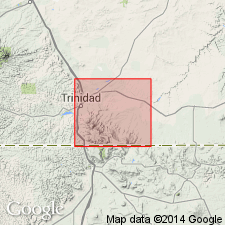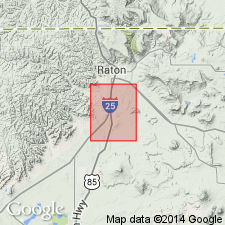
- Usage in publication:
-
- Beshoar Alluvium*
- Modifications:
-
- Named
- Dominant lithology:
-
- Alluvium
- AAPG geologic province:
-
- Las Vegas-Raton basin
Summary:
Named for Beshoar, an abandoned railway station on the Colorado and Southern Railway, Las Animas Co, CO in the Las Vegas-Raton basin. Name adapted from name Beshoar surface (Levings, W. S., 1951, Late Cenozoic erosional history of the Raton Mesa region: Colorado School of Mines Quarterly, v. 46, no. 3). Type locality designated in sec 35, T32S, R63W. Is a bouldery, cobbly, pebbly, sandy alluvium that contains some silt and clay. Clasts are mainly Tertiary and Precambrian igneous rocks, but some are Cretaceous sandstone. Has a well-developed soil in the upper part. Is about 20 ft (6 m) thick. Covers pediments about 120 to 140 ft (36 to 72 m) above major streams in the Raton basin of southeastern CO and northeastern NM. Probably formed during the early middle Pleistocene during an interglacial period that started about 600,000 years ago and ended some thousands of years later.
Source: GNU records (USGS DDS-6; Denver GNULEX).

- Usage in publication:
-
- Beshoar Alluvium*
- Modifications:
-
- Age modified
- AAPG geologic province:
-
- Las Vegas-Raton basin
Summary:
Age modified from early middle Pleistocene to middle middle Pleistocene based on Richmond's (1985, Quaternary Science Review, v.5, p.99-127) subdivision of the Pleistocene; probably deposited during interglacial time, about 600,000 years ago and ending thousands of years later. Probably equivalent to Verdos Alluvium of the Colorado Front Range.
Source: GNU records (USGS DDS-6; Denver GNULEX).
For more information, please contact Nancy Stamm, Geologic Names Committee Secretary.
Asterisk (*) indicates published by U.S. Geological Survey authors.
"No current usage" (†) implies that a name has been abandoned or has fallen into disuse. Former usage and, if known, replacement name given in parentheses ( ).
Slash (/) indicates name conflicts with nomenclatural guidelines (CSN, 1933; ACSN, 1961, 1970; NACSN, 1983, 2005, 2021). May be explained within brackets ([ ]).

